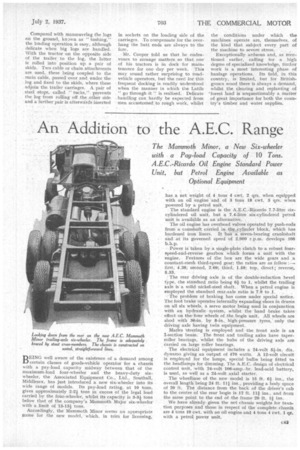An Addition to the A.E.C. Range
Page 89

If you've noticed an error in this article please click here to report it so we can fix it.
The Mammoth Minor, a New Six-wheeler with a Pay-load Capacity of 10 Tons. A.E.C.-Ricardo Oil Engine Standard Power Unit, but Petrol Engine Available as Optional Equipment
BEING well aware of the existence of a demand among certain classes of goods-vehicle operator for a chassis with a pay-load capacity midway between that of the maximum-load four-wheeler and the heavy-duty six. wheeler, the Associated Equipment Co., Ltd., Southall, Middlesex, has just introduced a new six-wheeler into its wide range of models. Its pay-load rating, at 10 tons, gives approximately 2-21 tons in excess of the legal load carried by the four-wheeler, whilst its capacity is 3-3* tons below that of the company's Mammoth Major six-wheeler with a limit of '13-13i tons.
Accordingly, the Mammoth Minor seems an appropriate name for the new model,' which, in trim for licensing, has a net weight of 4 tons 4 cwt. 2 qrs. when equipped with an oil engine 'and of 3 tons 18 cwt. 3 qrs. when powered by a petrol unit. The standard engine is the A.E.C.-Ricardo 7.7-litre sixcylindered oil unit, but a 7.4-litre six-cylindered petrol unit is available as an alternative.
The oil engine has overhead valves operated by push-rods from a camshaft carried in the ,cylinder block, which has hardened iron liners. It 'hat a seven-bearing crankshaft and at its governed speed of 2,000' r.p.m. develops 108 Power is taken by a single-plate clutch to a robust fourspeed-and-reverse gearbox which forms a unit with the engine. Features of the box are the wide gears and a constant-mesh third-speed gear; the ratios are as follow:— first, 4.38; second, 2.69; third, 1.59; top. direct ; reverse, 5.33.
The rear driving axle is of the double-reduction bevel type, the standard ratio being 61 to 1, whilst the trailing axle is a solid nickel-steel shaft. When a petrol engine is employed the standard rear-.axle ratio is 7.9 to .1.
The problem of braking has come under special notice. The foot brake operates internally expanding shoes in drums on all six wheels, a servo motor being used in conjunction with an hydraulic system, whilst the hand brake takes effect on the four wheels of the bogie unit. All wheels are shod with 36-in. by 8-in. high-pressure tyres, only the driving axle having twin equipment.
Marles t ee ri n g is employed and the front axle is an I-section beam. The front and trailing axles have taperroller bearings, whilst the hubs of the driving axle are carried on large roller bearings.
The electrical equipment includes a 24-volt 5i-in. dia. dynamo giving an output of 470 watts, A 12-volt circuit is employed for the lamps, special bulbs being fitted to the headlamps for dimming. The A.E.C. design of electrical control unit, with 24-volt 106-amp.-hr. lead-acid battery, is used, as well as a 24-volt axial starter.
The wheelbase of the new model is 15 ft. 61 ins., the overall length being 24 ft. 1 it ins., providing a body space of 20 ft. The distance from the back of the driver's cab to the centre of the rear bogie is 12 ft. 111 ins., and from the same point to the end of the frame 20 ft. la ins.
We have already given the net chassis weights for taxation, purposes and those in respect of the complete. Chassis are 4 tons 10 cwt. with an oil engine and 4 tons 4 cwt. 1 qr. with a petrol power unit.




















































































































































